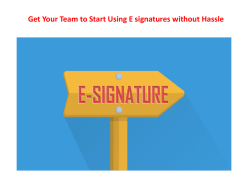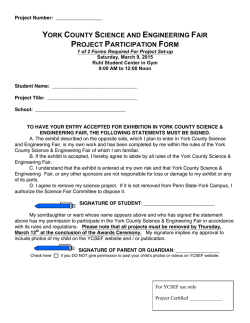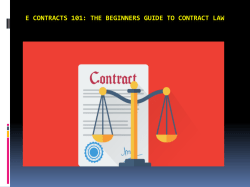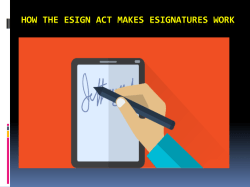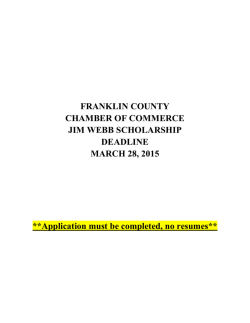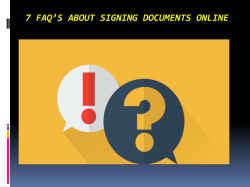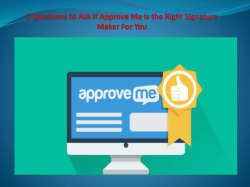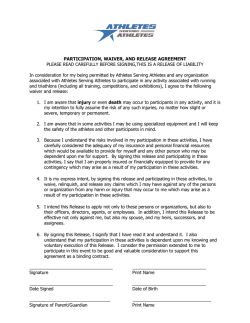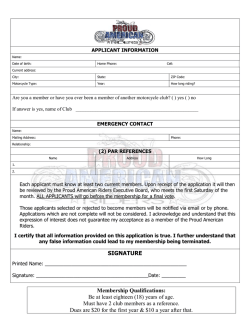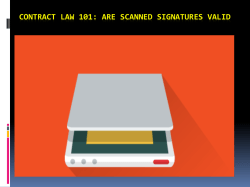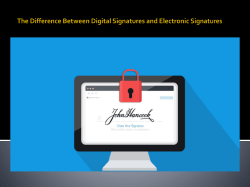
What Counts As An Esignature
WHAT COUNTS AS AN ESIGNATURE? Here we are in 2016 and we can do pretty much everything online. We can buy groceries, those cool boots we have been wanting for weeks, even get a doctor to diagnose that itch we got when we went on holiday last month. It is useful being able to do stuff online. It saves us time, and it’s just convenient. Doing jobs and tasks online is also beneficial to our business too. One area that has made major in-roads in terms of convenience, whilst adding legal weight to our business relationships, is the electronic signature. This post will take a look at what an electronic signature or esignature is, where you can and can’t use electronic signatures, what makes an esignature legal, and some other tricky questions that enquiring minds ask. What Exactly Is An Esignature? When you create a contract with another person or company, you sign off the contract using a signature from all parties. In the past this was a pen and ink signature. Pen and Ink Notaries often oversee the signature process and check that the signatory is who they say they are using identifying documents, like passports. Pen and ink signatures are on hard copy paper. If you made changes to the document, they’d have to stand up in court if challenged. The person’s signature itself can be checked as their true signature, against other copies of their writing and signatures. A hard copy paper signed document has to be sent to each signatory, or have all signatories come together to sign it. ELECTRONIC SIGNATURE A method to ‘authenticate’ the signatory, i.e. identify them uniquely, this is usually a digital certificate which is an electronic way of identifying someone The document content is ‘hashed’ by the esigning software product. Hashing creates a unique ‘fingerprint’ of the content. If that fingerprint changes at any time, e.g. someone tries to change a clause in the contract, the hash changes with it and this can be identified by the signature software The electronic signature of a person is made using a digital certificate – issued by a ‘certificate authority’ (CA). The CA checks a person’s identity. You can see who the signatory is by looking at the public key of their digital certificate that was used to sign the document. The certificate encrypts the hash of the document when the signature is applied – tying the signature and the document together Multiple electronic signatures can be applied to a document remotely and from a central place – this is one of the big advantages that using an electronic signature product like ApproveMe gives you. The mechanisms shown above mean that electronic signatures carry as much weight as a pen and ink signature. They offer protection that the document hasn’t been changed after signing. Some solutions, like ApproveMe will give you an audit trail of signing events, showing who has signed, their identity, IP address and so on – you can’t get that from a pen an ink signature. When Would You Use an Electronic Signature? So, now you have a way of signing an electronic document, that is equivalent to a pen and ink signature, when would you use an electronic signature? In 2000 the U.S. government passed a federal law, the Electronic Signatures in Global and National Commerce Act also known as ESIGN. This law gave electronic signatures the same level of legal protection as pen and ink signatures. Now we have a law covering the use of an electronic signature it means we can use them on a variety of contracts. However, this is where a caveat comes in. When you choose an electronic signing solution, it needs to be one that has been designed and built to the requirements of the ESIGN law. Some signing solutions do not conform to ESIGN, and if you end up in a dispute over a contract that was signed using a non-compliant solution, you may not be able to argue your case. Other parts of the world have their own esigning laws. In Europe, for example, this is EU Directive 1999/93/EC. What Contracts Can’t Be Signed With An Esignature? It’s simpler to say which contracts can’t be signed electronically than which can, as in the main, electronic signatures are accepted on most contract types. The sorts of contracts and documents that can’t be electronically signed are those needed for: Wills Trusts Adoption Divorce Official court document and court orders What Counts as an Electronic Signature? There are different types of esignatures. You could simply add an image of your written signature to a document. But this isn’t counted as an electronic signature as the signature and the document could be easily manipulated. Electronic signatures have to be intrinsically tied, in some manner, to the document itself. To make an esignature legal, you need to have in place a way to identify the signer electronically, a way to validate the signature, and a method of ensuring the document hasn’t changed since signing. Identifying the signer: To electronically sign a document the signatory needs to be identified. This is usually in the form of a digital certificate. You can get digital certificates, online from ‘certificate authorities’. Certificates have two parts, a private and a public key. The private key of the certificate is used to add the signature to the document – encrypting the hash made from the document content; the public key can be viewed by anyone to check the signer’s identity. Validate the signature: Checks need to be in place to make sure the signature is tied to the person. You should be able to see all signature details using an audit trail, including, the signers name, when it was signed, and even their IP address. Checking the document hasn’t changed: The signing software is used to hash the document (create the unique fingerprint). When a signature is checked, the hash is compared and if it has changed, the signature becomes invalid. When you use an electronic signature, it replaces your hand written signature. Although you may add an image of your signature to an electronically signed document, you don’t have to, and it certainly doesn’t need to look like your handwritten signature. Electronic signing is something that is taking over the pen and ink signature. Esigning platforms, like ApproveMe, give you effective digital signing that makes the document signing ceremony a much more seamless and integrated process. You don’t need to spend large amounts of time chasing up signatories, and you have a signed contract at the end that you can feel confident about and will stand up in a court of law. Article Resource: https://www.approveme.com/e-signature/what-counts-as-anesignature/
© Copyright 2025
